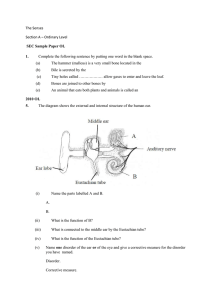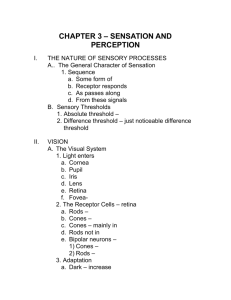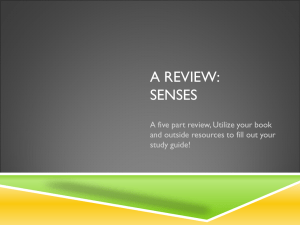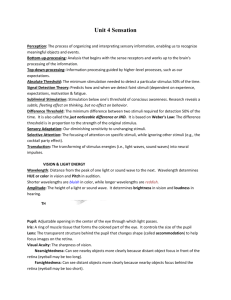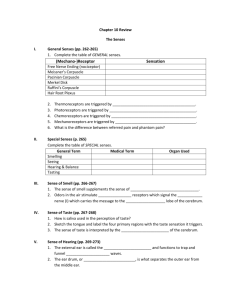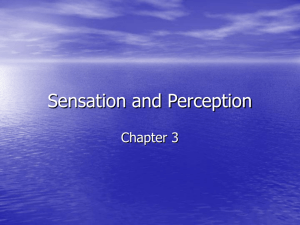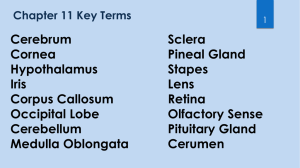Psych 4.1.2 PPT - heather-auten
advertisement
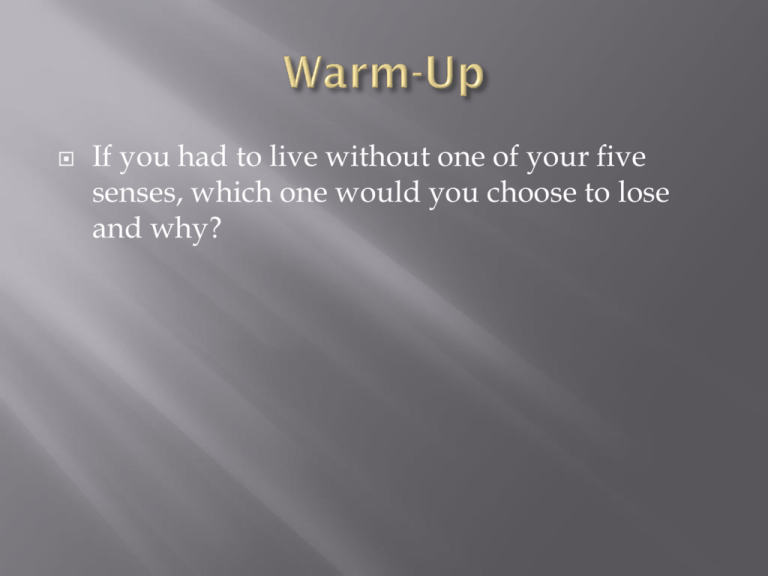
If you had to live without one of your five senses, which one would you choose to lose and why? An Introduction Sensation The stimulation of sensory receptors and transmission of information to the central nervous system. Perception Psychological process through which we interpret sensory stimulation Absolute Threshold The weakest amount of stimulus that can be sensed. Difference Threshold The minimum amount of difference that can be detected between two stimuli. Sense Stimulus Receptors Vision Electromagnt Rods and ic Energy cones in the retina Threshold A candle flame viewed from a distance of about 30 miles on a dark night. Hearing Sound Waves Hair cells of the inner ear The ticking of a watch from about 20 feet away in a quiet room. Smell Chemical substances in the air Receptor cells in the nose About one drop of perfume diffused throughout a small house. Taste Chemical substances in saliva Taste buds on the tongue About 1 teaspoon of sugar dissolved in 2 gallons of water. Touch Pressure on the skin Nerve endings in the skin The wing of a fly falling on a check from a distance of about .4 inch. Signal-Detection Theory Your environment, physical state, mood, and your attitude can affect sensitivity to stimuli. Sensory Adaptation Process by which we become more sensitive to weak stimuli and less sensitive to unchanging stimuli. Light is electromagnetic energy. We only see ROYGBIV, this is only a fraction of all the possible colors in the electromagnetic spectrum. (infrared and ultraviolet light) The Pupil Lets in light. (think of a camera lens) Pupil size is sensitive to light and emotions. Allows dark and light adaptation for up to 45 minutes. Lens Adjusts to the distance of objects by changing its thickness. When people squint, they are adjusting the thickness of the lenses in their eyes. Retina Sensitive surface – acts like the film of a camera. Photoreceptors make it possible for the optic nerve to carry the message to the brain. Cornea Protects the eye from germs, dust, etc. Contributes most of the eyes focusing power. Iris Colored portion of the eye. Optic Nerve Transmits visual information to the occipital lobe of the brain. Blind Spot Spot where optic nerve leaves the eye Rods and Cones Located in the Retina Rods are sensitive only to light, black and white. Cones provide color vision. Visual Acuity The sharpness of vision Afterimages The color’s complementary color. Colorblindness People who do not have normal color vision. They are partially or totally unable to distinguish color due to an absence of, or malfunction in, the cones. Total color blindness is rare. Partial color blindness is fairly common. Red-Green color blindness is the most common. Far more common among men because the deficiency is carried in the X chromosome. Answer 25 Answer 29 Answer 56 Answer 6 Answer 8 Colorblindness occurs in ______________ more often than in ______________. What is the function of the Rods and Cones in the eye? What happens if there is a problem with the Cones? What are afterimages? What is the spot called where the optical nerve leaves the eye? Sound travels through the air in waves. Changes in air pressure that result from vibration causes sound waves. Anything that makes a sound causes a vibration. http://www.youtube.com/watch?v=s9GBf8y0lY0 Pitch How high or low a sound is. The Human ear can hear sound waves from 20 to 20,000 cycles per second. Loudness Is determined by amplitude – Sound Waves. Loudness is measured by decibels (dB) 0 dB is the lowest we can hear. The shape of the ear is specifically made to capture sound. 3 sections of the ear Outer (what we typically think of as the ear) Middle (stretches from the eardrum through 3 small bones) Inner (consists of the cochlea and attaches to the auditory nerve) Eardrum is the gateway for outer to middle ear. As it vibrates it sends the vibration to 3 small bones in the middle ear. Hammer Anvil Stirrup Those bones then send the vibration to the inner ear. It reaches the cochlea, which looks like a snail, but is a bony fluid filled tube that contains neurons and then connects to the auditory nerve. About 2 million Americans are deaf. Deafness may be inherited, caused by disease, injury or old age. Conducive deafness is caused by damage to the middle ear. Usually in older people (can be helped with hearing aids. Sensorineural deafness is caused by damage to the inner ear. Usually caused by damage to the auditory nerve through disease or prolonged exposure to very loud noises. Smell, Taste, and Touch The receptor for the sensation of smell is the nose. The olfactory nerve is the connection to the brain from the nose. Taste and Smell are closely related. There are four basic taste qualities. Sweet Sour Salt Bitter Taste is sensed through receptors on the tongue called taste buds. Scraping or burning your tongue kills taste buds, they renew in about a weeks time. The are three ways we understand touch. Pressure is received by receptors around hair roots. Pressure Temperature Pain Different parts of the body are more sensitive than others. Temperature is sensors that help you adapt to temperature changes. These are neurons just below the skin. Pain is adaptive because it motivates us to do something to make it stop. Pain goes from its point of contact – the spinal cord – to the thalamus – to the cerebral cortex, where prostaglandins, or chemicals that tell the brain of the pain, are released. The Gate Theory suggests that only a certain amount of information can be processed so if you rub or scratch the area it helps pain go away. By doing so you flood the neurons. Vestibular Sense tells you whether you are physically upright or upside down. Sensory organs located in the ear monitor the body’s motion, balance, and tells you whether you are upside down or falling. Kinesthesis is “to move” and “perception. It is when information is fed to the brain from sensory organs in the joints, tendons, and muscles.
